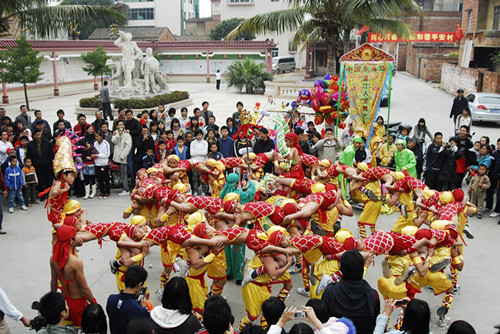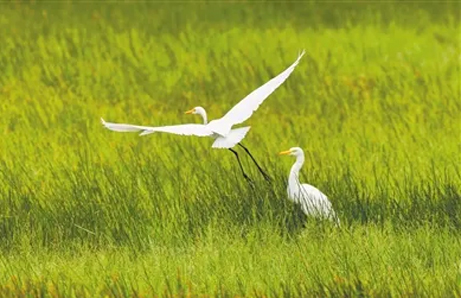Home> Arts and Traditions
Dancing with dragons
 |
| Human dragon dance [File Photo] |
The legends and auspicious characteristics of dragons are indelibly intertwined and woven deep within the thread of Chinese culture. The mythical beasts are worshipped and revered so much that most emperors would use dragons as they official crest or seal.
Along the Leizhou Peninsula in Zhanjiang, a dragon dance has been performed by local men and children for more than 300 years.
First arising in the late Ming (1368-1644) and early Qing (1644-1911) dynasties, the dance traditionally takes place over a three-day period during Mid-autumn Festival celebrations. It is said that it was first performed in Shentang village to honor the building of an embankment by Chen Shikai, a local official at the time.
Emerging from the sea, an unbroken human chain of men with children aged 12 to 13 sitting on their shoulder, snakes and sallies forth. The men are the dragon's feet, with the children its head, back, and tail. The children must be very flexible, laying backwards and resting their head on the right shoulder of the man behind, while wrapping their legs around the shoulders of the man in front.
 |
|
Human dragon dances have been a major draw card at festivals and celebrations for more than 300 years. [Photo/Xinhua] |
As the fantastic creatures make their way up the beach, they are accompanied by the sound of drums, gongs, and trumpets heralding their arrival and bringing luck to all.
It is critical for both man and child to work together in precise coordination in order for the dance to be a success, displaying the dexterity and unity of human cooperation. Dragons can range in length from 10 to tens of meters depending on how many people take part.
Included as an intangible cultural legacy, the dance has inspired people for generations, right up until present day. In 2016, the dance inspired the song Soul of a Human Dragon, one of the most popular village ballads of that year.

 Print
Print Mail
Mail 5G construction supports Zhanjiang's high-quality development
5G construction supports Zhanjiang's high-quality development
 Acting mayor inspects project construction in Xuwen, Leizhou
Acting mayor inspects project construction in Xuwen, Leizhou Zhanjiang island an "egret paradise"
Zhanjiang island an "egret paradise"  Dancing egrets add vitality to Xiashan
Dancing egrets add vitality to Xiashan